 Facebook
Facebook
 X
X
 Instagram
Instagram
 TikTok
TikTok
 Youtube
Youtube
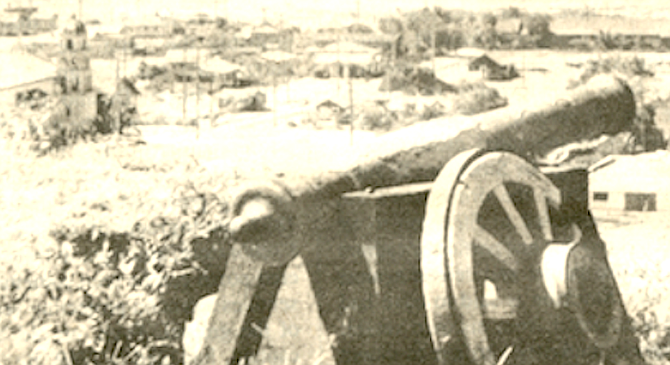
Hold your right hand out flat, palm down, fingers together, thumb outstretched. Your fingers are the tip of Pt. Loma, your thumb is Ballast Point, and the year is, say, 1800. In the crook of your thumb is Fort Guijarros, a primitive Spanish garrison newly built to guard the bay of San Diego and the desolate little mission in the valley to the east. Aiming into the bay are a number of deadly cannons, probably ten, set to engage any enemy corsair foolish enough to sail round your fingers and assault this frontier outpost of New Spain.
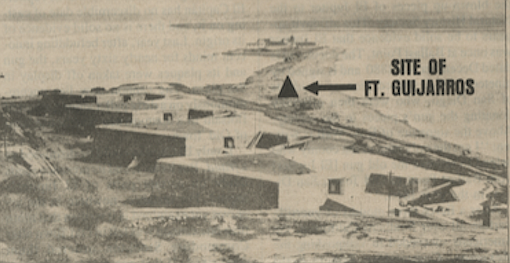
Now move your fingers and thumb figuratively forward through the decades, past the 1820s when Mexico won its independence and manned the fort, and through the 1830s, when the Mexicans abandoned it. Notice that some of the elegant old guns are strewn among the cobblestones, the guijarros, at the foot of the fort’s crumbling walls, and other cannons have disappeared altogether. It is 1846 and the American invaders ease past your hand — the fort at thumb’s crook in neglected ruin — to do battle with the Mexicans at Old Town and claim San Diego for President Polk. Pull your hand into a fist, turn it over, and open it. There are no cannons in your palm. What became of the guns of Ft. Guijarros?
That’s what Wayne Kenaston, Alexa Luberski, and Roy Pettus would like to know. Kenaston is in the insurance business but his heart is in local history and old cannons. His initiation of the yearly reenactment of the 1803 battle of San Diego Bay, in which Ft. Guijarros traded salvos with a fleeing Yankee ship that was smuggling out sea otter pelts, eventually led to the recent discovery and excavation of the old fort site. Alexa Luberski, who works for the state as historian of Old Town, is one of a group of experts and archaeologists piecing together the facts about Ft. Guijarros’s guns. Roy Pettus is a marine archaeologist searching for the guns on the bottom of the bay. So far the three of them haven’t pried open the mystery into which the cannons have vanished, although they’ve turned up enough tantalizing clues for a nonscientist like Kenaston to adopt the belief that two of contemporary San Diego’s legendary old artillery pieces were originally mounted at the Spanish fort. The more cautious Luberski and Pettus aren’t so sure. Either way, the guns of Ft. Guijarros remain stubbornly clenched in a fist of time.
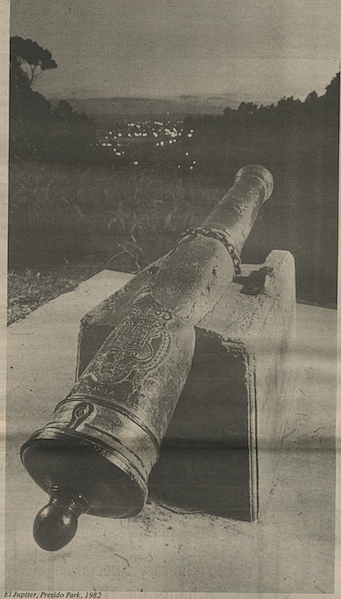
Up in Presidio Park, on a eucalyptus-covered knoll above Old Town, the bronze cannon “El Jupiter” is battened into a crude blob of concrete. From this perch, which is the former site of Fort Stockton, where the American invaders garrisoned temporarily in 1846 and ’47, El Jupiter’s muzzle aims toward Pt. Loma and Ft. Guijarros, where local legend holds it was originally emplaced. The artfully tooled gun itself tells you certain things about its past. Its name is imprinted in a decorative banner that curls near the gaping mouth. Engraved on the butt is the year (1783) and the location (Manila, part of the Spanish Philippine colony at that time) of its casting. Its maker, Phelipe Monzo, even autographed his handiwork. But the gun’s condition today does not well serve Senor Monzo’s good name. Jagged cracks riddle the barrel where its pieces were rejoined after it was blown to shrapnel by young pranksters in 1880. A big ugly scab of graffiti-like lead fills in the chunk of bronze that was never found. The once proud weapon has a slight bow to it now, the result of the shoddy patch job. If this is a Ft. Guijarros gun, its treatment over the last 135 years can safely be termed disgraceful.
El Jupiter went on duty at Ft. Stockton in 1929. It was placed there by George Marston as an addendum to the nearby Junipero Serra Museum, which he built and donated to the city. He secured the cannon from the Natural History Society, which had it in storage in the basement of the Cecil Hotel downtown on Sixth Avenue between C and B streets. It is a measure of the artifact’s neglect that when Marston formally asked for the gun, J.W. Sefton, Jr., head of the Natural History Society, replied in a letter, “Frankly, I was not aware that we had such a cannon, and, if we have, I don’t know where it is.” The lot where the Cecil Hotel stood was owned by the Natural History Society, and for many years before taking over its current quarters in Balboa Park, the society used some basement rooms at the hotel for meetings and storage. Marston knew of the cannon because his department store, which occupied the same block, was annexing the hotel, and his employees had had to move the 2000 pounds of Spanish bronze too many times.
As far as can be determined, the cannon had been in the basement since the end of the Panama-Califomia Exposition of 1915, judging from Natural History Society records which show that it was loaned to the exposition. Prior to that time it had been variously loaned and stored by the society; the famous gun even traveled as far as the Chicago World’s Fair of 1893. Not a bad itinerary for a relic that was in half a dozen pieces when the society obtained it in 1881.
Just how the gun came to be blown up is a story so mangled and embellished over the years that sorting it out and telling it again entails risking one’s credibility. Here goes: In 1876 El Jupiter was mounted on a sturdy carriage and sitting in Old Town Plaza, where it had stood since the Mexican-American War in 1846. The presidential election of 1876 was a particularly bitter and scandalous one that pitted Republican Rutherford B. Hayes against Democrat Samuel J. Tilden. Although Tilden won the popular vote by a big margin, 4,285,992 to Hayes’s 4,033,768, he lost in the electoral college by one vote. For a time zealous San Diego Democrats thought their man was elected, and in order to celebrate they moved El Jupiter from Old Town to an empty lot at New Town on D Street (Broadway) between State and Columbia. It took four months for Congress to decide the contested election in Hayes’s favor, during which time the cannon stood ready to sound Tilden’s victory. It is not known whether Hayes’s followers fired the gun, nor whether it ever made its way back to Old Town. But in 1880 it ended up in front of the Phoenix Saloon in the 700 block of Sixth Avenue. The San Diego Historical Society is said to have protested to the city trustees this ignominious fate, so the city fathers told the saloon’s proprietor, Till A. Burnes, to move the gun back to Old Town. The story is that Burnes got it as far as the empty lot between Second and Third avenues and E and F streets when one of the big wheels fell off. It sat there catty wampus until one night between Christmas and New Year, when friends of a newlywed groom decided to celebrate by firing the cannon. Unfortunately, they loaded it with too much powder and packed it too firmly with mud; when they touched it off, pieces of El Jupiter ended up as far away as Fourteenth and K streets, ten blocks away.
The saddened citizens of Old Town, who numbered quite a few original pioneers, entrusted what was left of their mortally wounded cannon to the Natural History Society. El Jupiter’s explosive demise was an occasion for retelling its legend and its links to Ft. Guijarros, and the newspapers of the day seized the opportunity to confuse and obscure the facts. Which is one reason why archaeologists aren’t convinced the gun came from Ft. Guijarros.
From a study of the archives in the Serra Museum, it can be stated as a matter of fact that some of the cannons at Ft. Guijarros were moved up to the presidio, which was the Spanish fort above Old Town. It is widely said, though not yet proven, that the Mexicans brought up two of the guns in 1838. It’s much more certain, based on a seaman’s log written at the time, that the first American forces to land in 1846 took from Ft. Guijarros six “brass” (often confused with bronze) nine-pounders — cannons that shot nine-pound balls, as did El Jupiter — and dug them in at the west end of Old Town. (These guns were later moved up to Ft. Stockton, which we know as Presidio Park.) This is explicitly detailed not only in Midshipman Duvall’s log of the Savannah, but also in the affidavit of one of the early pioneers who later gave the blown-up pieces of El Jupiter to the Natural History Society. This affidavit appears to be solid evidence that El Jupiter was once at Ballast Point. The document is dated December 30, 1880 and is signed by nineteen self-described pioneer residents of San Diego, who were then officially donating the gun’s pieces to the society. Above the signature of E.A. Wall is written: “l am the only man in the county who helped to remove the old gun [El Jupiter] from Ballast Point to Old Town, San Diego, in the year 1846.”
After a fierce three months of guerrilla warfare all over Southern California, the Americans succeeded in vanquishing the Mexicans. Commodore Robert Field Stockton, legend holds, returned to San Diego after reconquering and securing Los Angeles, and here he ordered that all the cannons, those brought up from Ft. Guijarros by the Americans as well as the ones captured from the Mexicans, be dumped into the bay. According to Phillip Crosthwaite, who was appointed alcalde (constable) of San Diego by Stockton, El Jupiter was saved from the drink when he, Crosthwaite, appealed to Stockton to let the citizens keep this one particular cannon in order to fire salutes and defend against the Indians. Stockton is said to have had the ship’s carpenter from his own vessel, the Congress, make the carriage to mount the gun. It is presumed that the remaining guns of Ft. Guijarros were cast into the bay.
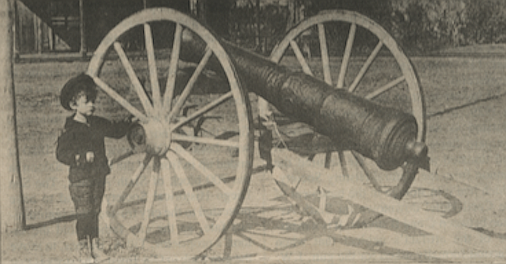
The legend of El Jupiter would be a tidy little piece of Americana, quaint and fairly oozing with historic drama, if another Old Town cannon hadn’t stormed in to rain down havoc upon history. The turbulence is an iron cannon called El Capitan. Over the decades the two guns, both nine-pounders, have become so intertwined and their stories confused by so many misinformed writers that even a respected historian, William Smythe, badly injured history when he undertook the telling of the cannons’ story. Included in Smythe’s History of San Diego is one of the nicer photographs of El Jupiter, under which is the patently false caption identifying it as El Capitan. The city fathers themselves compounded the confusion in 1923 when they helped Boy Scout Troop #30 mount the iron gun in Old Town Plaza. The plaque they mounted with the cannon said the piece was cast in Manila in 1783 and was brought here in 1800, which would be fine if the gun it referred to was El Jupiter. El Capitan has no discernible date of casting on it, and there is no solid evidence of its origin. Last year, after befuddling innocent minds for nearly sixty years, the gun and its plaques were taken off display in the plaza. The cannon now lies unceremoniously on a dirty pallet among assorted flotsam in a state-owned warehouse west of Old Town.
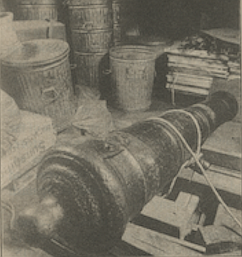
If only El Capitan could be dismissed as a fraud. But it can’t, and its presence sheds doubt on certain parts of El Jupiter’s legend. For instance, nowhere in the archives yet examined is it written that more than one cannon was left in Old Town after Commodore Stockton ordered them deep-sixed. If that one gun is El Jupiter, where the devil did El Capitan come from? And why is it even called El Capitan?
It seems safe to assert that the gun is probably the same one that was stuck muzzle-first into the ground in front of Captain Henry Delano Fitch’s general store in Old Town in the mid-1800s. There are references in early newspapers to an old cannon being used there as both a hitching post and a whipping post. An 1872 photograph of Old Town shows Fitch’s store, and right in front of the covered porch can be seen something that resembles a cannon projecting vertically out of the ground. Fitch, an old Yankee sea captain, had died in 1849, just after completing construction of the store. It’s not known precisely when the cannon was planted, or where it came from, but evidently it stayed on the comer of the property well after the building was abandoned in the late 1870s. A newspaper story published in 1887 refers to the cannon still being there upright. Later photographs from the 1890s picture no gun on the Fitch property, but do show a cannon lying in Old Town Plaza.
An undocumented passage in the Fitch family papers reads, “For many years, the cannon in the plaza, which had been anchored in the earth, served as a hitching post for the store.” That cannon eventually found itself mounted in the plaza by do-gooding Boy Scouts in 1923.
Assuming Fitch’s hitching and whipping post is now the cannon that’s been heaved into a dank warehouse, the essential questions remain: Why is it called El Capitan? Nobody knows for sure, but perhaps because it was owned by somebody referred to as “captain,” which presumably Fitch was. Where did it come from? For all that’s known about it, the gun could have been an old relic the sea captain acquired during his travels, which would argue against its being a Ft. Guijarros cannon. But maybe there’s another explanation.
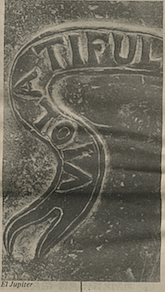
In the legend of El Jupiter, the bronze gun was for a time referred to as ‘ ‘El Canon de don Miguel de Pedrorena.” Nearly every published history of El Jupiter says that Senor Pedrorena, one of Old Town’s most prominent and respected citizens in the early 1800s, buried the cannon in 1846 to keep the Americans from throwing it into the bay. It has been established that Phillip Crosthwaite (specifically) saved El Jupiter from a watery grave. So if Pedrorena buried a gun in order to preserve it, why would he have dug it up before the American soldiers took their leave? The logical conclusions are these: Senor Pedrorena was hopelessly stupid, which he in fact was not; the Americans discovered the hidden gun and confiscated it, which is unlikely; or the gun Pedrorena buried was not El Jupiter. But the only other cannon in Old Town after the Mexican War was the one now called El Capitan. How that gun came to be in Old Town in the first place is now, and probably will remain, a mystery.
For the sake of argument, assume — contrary to legend — that El Capitan was the gun once called El Canon de don Miguel de Pedrorena. How did Captain Fitch end up with it? The only clue uncovered so far is a list of some of the people with whom Fitch had business dealings. This list is in the Fitch family papers, some of which are held in trust by the San Diego Historical Society. Don Miguel de Pedrorena is on that list.
The view from Ft. Guijarros has changed in unimaginable ways since the 1840s. Ballast Point now harbors the Navy’s submarines. Abutting the fort’s excavation site (which has been filled in to protect it from the winter rains) is an asphalt road running between the water’s edge and the Navy Exchange building. Separating the fort site from the bay are tons of rip-rap, a wall of granite boulders. About the only things enduring from the fort’s heyday are the steep buff cliffs of Pt. Loma to the right, and guijarros — the crackling cobblestones on the shoreline. In morning light the fuselages of inbound airliners glint gold before disappearing toward Lindbergh Field to the extreme left. The choppy cityscape sends blunt towers above the heavy boat traffic on the bay. Arcing right, the Coronado Bridge is dwarfed before the indigo backdrop of San Miguel Mountain. Along the Silver Strand, the Hotel del Coronado is hunkered down like an intimidating sentry, guarding access to the boxy beachfront condominiums farther south. A jet fighter screams up into the sky from the North Island Naval Air Station, drowning out the bleating of a lone foghorn. Civilization overflows every view, and it has even spilled down onto the baybed, hampering Roy Pettus’s underwater search for the guns of Ft. Guijarros.
Most all of the bay bottom has been dredged or filled, so it was a triumph of sorts when the young marine archaeologist and his team of divers turned up some promising artifacts in their marine survey summer before last. Still, it will be something of a miracle if they come up with a cannon in next summer’s proposed investigation.
The inevitable difficulties of underwater archaeological research can hardly be overstated; still, Pettus and his crew were fortunate in some ways; the waters they searched off the southern edge of Ballast Point were mercifully free of dredging and filling, and were also calm and shallow. Rarely did the divers go deeper than twenty feet. It was a good place to search for the old cannons, but not the best place. The vague reports of Stockton’s dumping of the guns refer to their being sunk “in the deepest part of the bay.’’ Charts from the mid-1800s indicate that the area would be on the north side of Ballast Point, directly beneath the Navy’s nuclear submarines. Captain David Harscheid, commander of the base, says an underwater survey of that area is out of the question. He leaves open the chance that other areas along the northern edge of the point could be opened to Pettus and his divers next summer.
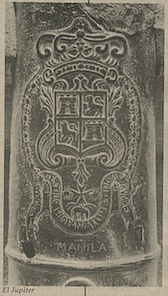
In the underwater search, which included both systematic visual surveys by scuba divers as well as remote magnetometer sensing and core sampling, several artifacts were recovered or recorded. The most dramatic was a complete set of rosary beads composed of wood, brass, and copper. The medallion is inscribed with religious symbols and the year 1830. Whoever owned it probably touched the guns Pettus is looking for. Ceramic shards and Indian grindstones (Indians inhabited Ballast Point before the Spanish) were also brought up. But as close as the group came to something resembling a cannon was the recording of an unusual blip by the magnetometer. A long metallic object appears to lie under ten feet of water and eight feet of sand. The archaeologists, who are funded only by modest contributions from the public, hope to excavate the anomaly next year. Whether it’s an old Spanish cannon, or a piece of pipe, or nothing, is anybody’s guess. If it’s a cannon, its days of solitary peace are numbered.


Hold your right hand out flat, palm down, fingers together, thumb outstretched. Your fingers are the tip of Pt. Loma, your thumb is Ballast Point, and the year is, say, 1800. In the crook of your thumb is Fort Guijarros, a primitive Spanish garrison newly built to guard the bay of San Diego and the desolate little mission in the valley to the east. Aiming into the bay are a number of deadly cannons, probably ten, set to engage any enemy corsair foolish enough to sail round your fingers and assault this frontier outpost of New Spain.

Now move your fingers and thumb figuratively forward through the decades, past the 1820s when Mexico won its independence and manned the fort, and through the 1830s, when the Mexicans abandoned it. Notice that some of the elegant old guns are strewn among the cobblestones, the guijarros, at the foot of the fort’s crumbling walls, and other cannons have disappeared altogether. It is 1846 and the American invaders ease past your hand — the fort at thumb’s crook in neglected ruin — to do battle with the Mexicans at Old Town and claim San Diego for President Polk. Pull your hand into a fist, turn it over, and open it. There are no cannons in your palm. What became of the guns of Ft. Guijarros?
That’s what Wayne Kenaston, Alexa Luberski, and Roy Pettus would like to know. Kenaston is in the insurance business but his heart is in local history and old cannons. His initiation of the yearly reenactment of the 1803 battle of San Diego Bay, in which Ft. Guijarros traded salvos with a fleeing Yankee ship that was smuggling out sea otter pelts, eventually led to the recent discovery and excavation of the old fort site. Alexa Luberski, who works for the state as historian of Old Town, is one of a group of experts and archaeologists piecing together the facts about Ft. Guijarros’s guns. Roy Pettus is a marine archaeologist searching for the guns on the bottom of the bay. So far the three of them haven’t pried open the mystery into which the cannons have vanished, although they’ve turned up enough tantalizing clues for a nonscientist like Kenaston to adopt the belief that two of contemporary San Diego’s legendary old artillery pieces were originally mounted at the Spanish fort. The more cautious Luberski and Pettus aren’t so sure. Either way, the guns of Ft. Guijarros remain stubbornly clenched in a fist of time.

Up in Presidio Park, on a eucalyptus-covered knoll above Old Town, the bronze cannon “El Jupiter” is battened into a crude blob of concrete. From this perch, which is the former site of Fort Stockton, where the American invaders garrisoned temporarily in 1846 and ’47, El Jupiter’s muzzle aims toward Pt. Loma and Ft. Guijarros, where local legend holds it was originally emplaced. The artfully tooled gun itself tells you certain things about its past. Its name is imprinted in a decorative banner that curls near the gaping mouth. Engraved on the butt is the year (1783) and the location (Manila, part of the Spanish Philippine colony at that time) of its casting. Its maker, Phelipe Monzo, even autographed his handiwork. But the gun’s condition today does not well serve Senor Monzo’s good name. Jagged cracks riddle the barrel where its pieces were rejoined after it was blown to shrapnel by young pranksters in 1880. A big ugly scab of graffiti-like lead fills in the chunk of bronze that was never found. The once proud weapon has a slight bow to it now, the result of the shoddy patch job. If this is a Ft. Guijarros gun, its treatment over the last 135 years can safely be termed disgraceful.
El Jupiter went on duty at Ft. Stockton in 1929. It was placed there by George Marston as an addendum to the nearby Junipero Serra Museum, which he built and donated to the city. He secured the cannon from the Natural History Society, which had it in storage in the basement of the Cecil Hotel downtown on Sixth Avenue between C and B streets. It is a measure of the artifact’s neglect that when Marston formally asked for the gun, J.W. Sefton, Jr., head of the Natural History Society, replied in a letter, “Frankly, I was not aware that we had such a cannon, and, if we have, I don’t know where it is.” The lot where the Cecil Hotel stood was owned by the Natural History Society, and for many years before taking over its current quarters in Balboa Park, the society used some basement rooms at the hotel for meetings and storage. Marston knew of the cannon because his department store, which occupied the same block, was annexing the hotel, and his employees had had to move the 2000 pounds of Spanish bronze too many times.
As far as can be determined, the cannon had been in the basement since the end of the Panama-Califomia Exposition of 1915, judging from Natural History Society records which show that it was loaned to the exposition. Prior to that time it had been variously loaned and stored by the society; the famous gun even traveled as far as the Chicago World’s Fair of 1893. Not a bad itinerary for a relic that was in half a dozen pieces when the society obtained it in 1881.
Just how the gun came to be blown up is a story so mangled and embellished over the years that sorting it out and telling it again entails risking one’s credibility. Here goes: In 1876 El Jupiter was mounted on a sturdy carriage and sitting in Old Town Plaza, where it had stood since the Mexican-American War in 1846. The presidential election of 1876 was a particularly bitter and scandalous one that pitted Republican Rutherford B. Hayes against Democrat Samuel J. Tilden. Although Tilden won the popular vote by a big margin, 4,285,992 to Hayes’s 4,033,768, he lost in the electoral college by one vote. For a time zealous San Diego Democrats thought their man was elected, and in order to celebrate they moved El Jupiter from Old Town to an empty lot at New Town on D Street (Broadway) between State and Columbia. It took four months for Congress to decide the contested election in Hayes’s favor, during which time the cannon stood ready to sound Tilden’s victory. It is not known whether Hayes’s followers fired the gun, nor whether it ever made its way back to Old Town. But in 1880 it ended up in front of the Phoenix Saloon in the 700 block of Sixth Avenue. The San Diego Historical Society is said to have protested to the city trustees this ignominious fate, so the city fathers told the saloon’s proprietor, Till A. Burnes, to move the gun back to Old Town. The story is that Burnes got it as far as the empty lot between Second and Third avenues and E and F streets when one of the big wheels fell off. It sat there catty wampus until one night between Christmas and New Year, when friends of a newlywed groom decided to celebrate by firing the cannon. Unfortunately, they loaded it with too much powder and packed it too firmly with mud; when they touched it off, pieces of El Jupiter ended up as far away as Fourteenth and K streets, ten blocks away.
The saddened citizens of Old Town, who numbered quite a few original pioneers, entrusted what was left of their mortally wounded cannon to the Natural History Society. El Jupiter’s explosive demise was an occasion for retelling its legend and its links to Ft. Guijarros, and the newspapers of the day seized the opportunity to confuse and obscure the facts. Which is one reason why archaeologists aren’t convinced the gun came from Ft. Guijarros.
From a study of the archives in the Serra Museum, it can be stated as a matter of fact that some of the cannons at Ft. Guijarros were moved up to the presidio, which was the Spanish fort above Old Town. It is widely said, though not yet proven, that the Mexicans brought up two of the guns in 1838. It’s much more certain, based on a seaman’s log written at the time, that the first American forces to land in 1846 took from Ft. Guijarros six “brass” (often confused with bronze) nine-pounders — cannons that shot nine-pound balls, as did El Jupiter — and dug them in at the west end of Old Town. (These guns were later moved up to Ft. Stockton, which we know as Presidio Park.) This is explicitly detailed not only in Midshipman Duvall’s log of the Savannah, but also in the affidavit of one of the early pioneers who later gave the blown-up pieces of El Jupiter to the Natural History Society. This affidavit appears to be solid evidence that El Jupiter was once at Ballast Point. The document is dated December 30, 1880 and is signed by nineteen self-described pioneer residents of San Diego, who were then officially donating the gun’s pieces to the society. Above the signature of E.A. Wall is written: “l am the only man in the county who helped to remove the old gun [El Jupiter] from Ballast Point to Old Town, San Diego, in the year 1846.”
After a fierce three months of guerrilla warfare all over Southern California, the Americans succeeded in vanquishing the Mexicans. Commodore Robert Field Stockton, legend holds, returned to San Diego after reconquering and securing Los Angeles, and here he ordered that all the cannons, those brought up from Ft. Guijarros by the Americans as well as the ones captured from the Mexicans, be dumped into the bay. According to Phillip Crosthwaite, who was appointed alcalde (constable) of San Diego by Stockton, El Jupiter was saved from the drink when he, Crosthwaite, appealed to Stockton to let the citizens keep this one particular cannon in order to fire salutes and defend against the Indians. Stockton is said to have had the ship’s carpenter from his own vessel, the Congress, make the carriage to mount the gun. It is presumed that the remaining guns of Ft. Guijarros were cast into the bay.

The legend of El Jupiter would be a tidy little piece of Americana, quaint and fairly oozing with historic drama, if another Old Town cannon hadn’t stormed in to rain down havoc upon history. The turbulence is an iron cannon called El Capitan. Over the decades the two guns, both nine-pounders, have become so intertwined and their stories confused by so many misinformed writers that even a respected historian, William Smythe, badly injured history when he undertook the telling of the cannons’ story. Included in Smythe’s History of San Diego is one of the nicer photographs of El Jupiter, under which is the patently false caption identifying it as El Capitan. The city fathers themselves compounded the confusion in 1923 when they helped Boy Scout Troop #30 mount the iron gun in Old Town Plaza. The plaque they mounted with the cannon said the piece was cast in Manila in 1783 and was brought here in 1800, which would be fine if the gun it referred to was El Jupiter. El Capitan has no discernible date of casting on it, and there is no solid evidence of its origin. Last year, after befuddling innocent minds for nearly sixty years, the gun and its plaques were taken off display in the plaza. The cannon now lies unceremoniously on a dirty pallet among assorted flotsam in a state-owned warehouse west of Old Town.

If only El Capitan could be dismissed as a fraud. But it can’t, and its presence sheds doubt on certain parts of El Jupiter’s legend. For instance, nowhere in the archives yet examined is it written that more than one cannon was left in Old Town after Commodore Stockton ordered them deep-sixed. If that one gun is El Jupiter, where the devil did El Capitan come from? And why is it even called El Capitan?
It seems safe to assert that the gun is probably the same one that was stuck muzzle-first into the ground in front of Captain Henry Delano Fitch’s general store in Old Town in the mid-1800s. There are references in early newspapers to an old cannon being used there as both a hitching post and a whipping post. An 1872 photograph of Old Town shows Fitch’s store, and right in front of the covered porch can be seen something that resembles a cannon projecting vertically out of the ground. Fitch, an old Yankee sea captain, had died in 1849, just after completing construction of the store. It’s not known precisely when the cannon was planted, or where it came from, but evidently it stayed on the comer of the property well after the building was abandoned in the late 1870s. A newspaper story published in 1887 refers to the cannon still being there upright. Later photographs from the 1890s picture no gun on the Fitch property, but do show a cannon lying in Old Town Plaza.
An undocumented passage in the Fitch family papers reads, “For many years, the cannon in the plaza, which had been anchored in the earth, served as a hitching post for the store.” That cannon eventually found itself mounted in the plaza by do-gooding Boy Scouts in 1923.
Assuming Fitch’s hitching and whipping post is now the cannon that’s been heaved into a dank warehouse, the essential questions remain: Why is it called El Capitan? Nobody knows for sure, but perhaps because it was owned by somebody referred to as “captain,” which presumably Fitch was. Where did it come from? For all that’s known about it, the gun could have been an old relic the sea captain acquired during his travels, which would argue against its being a Ft. Guijarros cannon. But maybe there’s another explanation.

In the legend of El Jupiter, the bronze gun was for a time referred to as ‘ ‘El Canon de don Miguel de Pedrorena.” Nearly every published history of El Jupiter says that Senor Pedrorena, one of Old Town’s most prominent and respected citizens in the early 1800s, buried the cannon in 1846 to keep the Americans from throwing it into the bay. It has been established that Phillip Crosthwaite (specifically) saved El Jupiter from a watery grave. So if Pedrorena buried a gun in order to preserve it, why would he have dug it up before the American soldiers took their leave? The logical conclusions are these: Senor Pedrorena was hopelessly stupid, which he in fact was not; the Americans discovered the hidden gun and confiscated it, which is unlikely; or the gun Pedrorena buried was not El Jupiter. But the only other cannon in Old Town after the Mexican War was the one now called El Capitan. How that gun came to be in Old Town in the first place is now, and probably will remain, a mystery.
For the sake of argument, assume — contrary to legend — that El Capitan was the gun once called El Canon de don Miguel de Pedrorena. How did Captain Fitch end up with it? The only clue uncovered so far is a list of some of the people with whom Fitch had business dealings. This list is in the Fitch family papers, some of which are held in trust by the San Diego Historical Society. Don Miguel de Pedrorena is on that list.
The view from Ft. Guijarros has changed in unimaginable ways since the 1840s. Ballast Point now harbors the Navy’s submarines. Abutting the fort’s excavation site (which has been filled in to protect it from the winter rains) is an asphalt road running between the water’s edge and the Navy Exchange building. Separating the fort site from the bay are tons of rip-rap, a wall of granite boulders. About the only things enduring from the fort’s heyday are the steep buff cliffs of Pt. Loma to the right, and guijarros — the crackling cobblestones on the shoreline. In morning light the fuselages of inbound airliners glint gold before disappearing toward Lindbergh Field to the extreme left. The choppy cityscape sends blunt towers above the heavy boat traffic on the bay. Arcing right, the Coronado Bridge is dwarfed before the indigo backdrop of San Miguel Mountain. Along the Silver Strand, the Hotel del Coronado is hunkered down like an intimidating sentry, guarding access to the boxy beachfront condominiums farther south. A jet fighter screams up into the sky from the North Island Naval Air Station, drowning out the bleating of a lone foghorn. Civilization overflows every view, and it has even spilled down onto the baybed, hampering Roy Pettus’s underwater search for the guns of Ft. Guijarros.
Most all of the bay bottom has been dredged or filled, so it was a triumph of sorts when the young marine archaeologist and his team of divers turned up some promising artifacts in their marine survey summer before last. Still, it will be something of a miracle if they come up with a cannon in next summer’s proposed investigation.
The inevitable difficulties of underwater archaeological research can hardly be overstated; still, Pettus and his crew were fortunate in some ways; the waters they searched off the southern edge of Ballast Point were mercifully free of dredging and filling, and were also calm and shallow. Rarely did the divers go deeper than twenty feet. It was a good place to search for the old cannons, but not the best place. The vague reports of Stockton’s dumping of the guns refer to their being sunk “in the deepest part of the bay.’’ Charts from the mid-1800s indicate that the area would be on the north side of Ballast Point, directly beneath the Navy’s nuclear submarines. Captain David Harscheid, commander of the base, says an underwater survey of that area is out of the question. He leaves open the chance that other areas along the northern edge of the point could be opened to Pettus and his divers next summer.

In the underwater search, which included both systematic visual surveys by scuba divers as well as remote magnetometer sensing and core sampling, several artifacts were recovered or recorded. The most dramatic was a complete set of rosary beads composed of wood, brass, and copper. The medallion is inscribed with religious symbols and the year 1830. Whoever owned it probably touched the guns Pettus is looking for. Ceramic shards and Indian grindstones (Indians inhabited Ballast Point before the Spanish) were also brought up. But as close as the group came to something resembling a cannon was the recording of an unusual blip by the magnetometer. A long metallic object appears to lie under ten feet of water and eight feet of sand. The archaeologists, who are funded only by modest contributions from the public, hope to excavate the anomaly next year. Whether it’s an old Spanish cannon, or a piece of pipe, or nothing, is anybody’s guess. If it’s a cannon, its days of solitary peace are numbered.